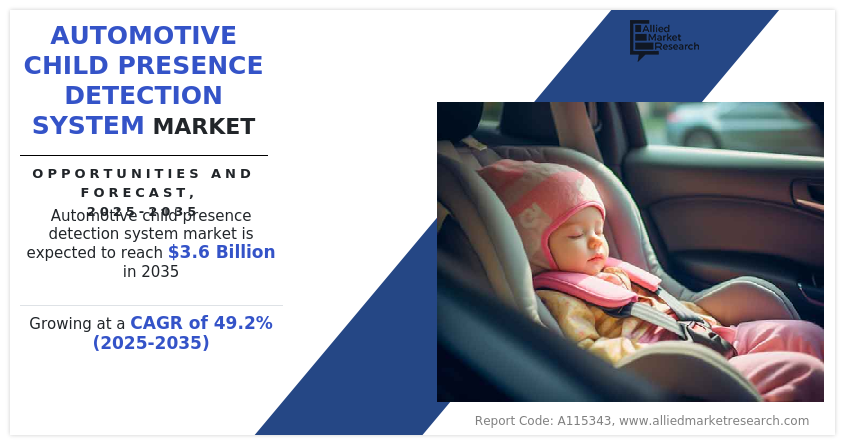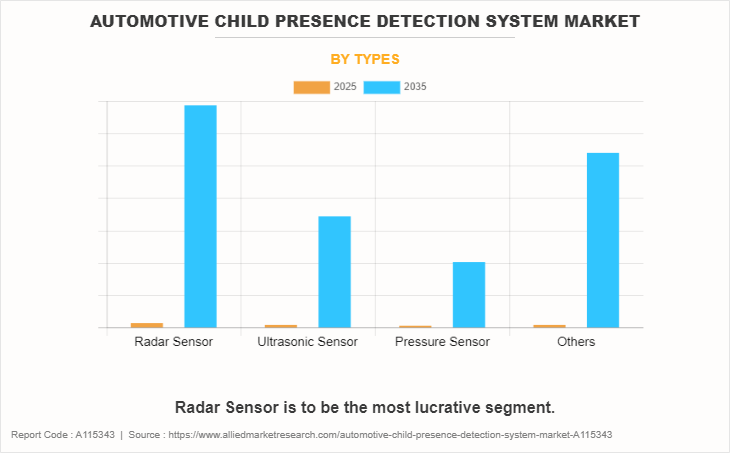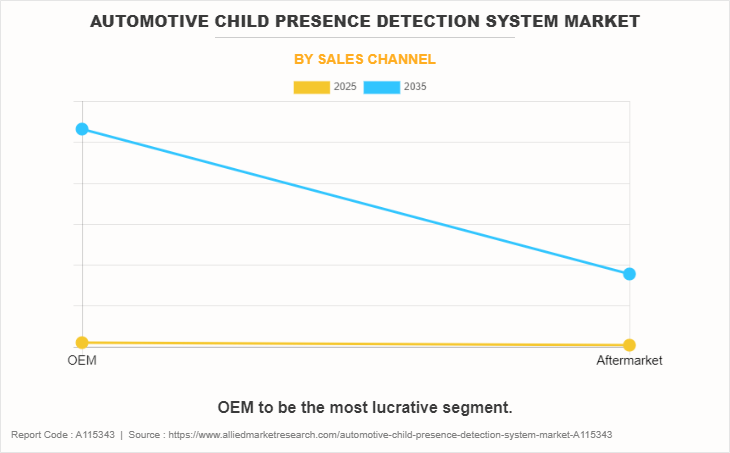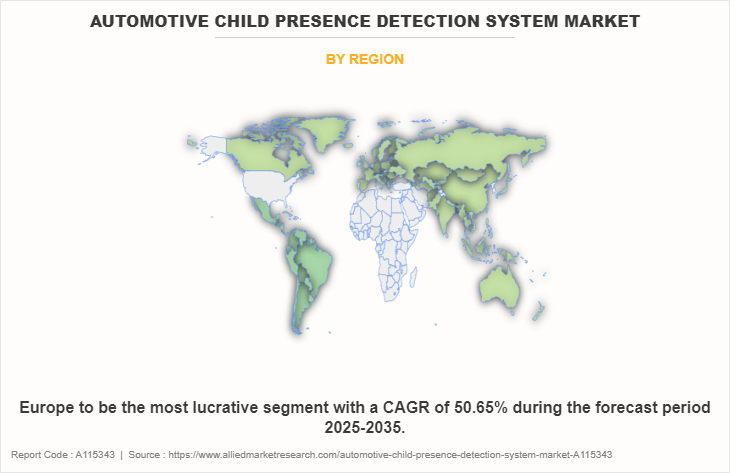Automotive Child Presence Detection System Market Insights, 2035
The global automotive child presence detection system market size was valued at $65 million in 2025, and is projected to reach $3.6 billion by 2035, growing at a CAGR of 49.2% from 2025 to 2035.
Report Key Highlights:
The automotive child presence detection system market trends covers 14 countries. The research includes regional and segment analysis of each country in terms of value ($million) for the projected period 2025-2035.
The study integrated high-quality data, professional opinions and analysis, and critical independent perspectives. The research approach is intended to provide a balanced view of global markets and to assist stakeholders in making educated decisions in order to achieve their most ambitious growth objectives.
Over 3,700 product literature, annual reports, industry statements, and other comparable materials from major industry participants were reviewed to gain a better understanding of the market.
The automotive child presence detection system market share is highly fragmented, into several players including Continental AG, Robert Bosch GmbH, Magna International Inc, APTIV PLC, Valeo, STMicroelectronics, Texas Instruments Incorporated, AISIN CORPORATION, FORVIA Faurecia and Visteon Corporation.The companies have adopted strategies such as product launches, contracts, expansions, agreements, and others to improve their market positioning.
Automotive child presence detection systems are solutions, which utilize various software and hardware such as radars, cameras, and others to detect the presence of unattended child or pet in a vehicle and inform the driver through visual or alarm warnings. The major aim of automotive child presence detection system is to provide comfortable, safe, and secure environment for children and is specifically developed for tracking children under the age of 5 years.

The instances of children trapped inside a vehicle, primarily due to being left in vehicle by parents, or they have gained access to vehicle on their own have increased significantly over the years. The temperature inside a locked vehicle rises faster. For instance, during the initial 10 minutes, the temperature inside a locked vehicle can reach 140 degree celsius.
According to a recent survey in the U.S, approximately 1,054 children have died, due to being trapped inside a vehicle during 1990 to 2022. According to the study in last 5 years, an average of 40 children have died every year. The report states majority of the death were caused by parents unknowingly leaving their child inside the car. With the growing global temperatures, especially during the warmer months, child left unattended in vehicles can be exposed to heath strokes and dehydration. Thus, resulting in increase in the number of cases of child death. Moreover, with rise in ownerships of personal cars globally, instances of child left unattended in car are anticipated to increase during the forecast period. Thus, contributing to the growth of the automotive child presence detection system market.
The expansion of the global automotive child presence detection system is driven by increase in the number of deaths due to children trapped inside vehicles, rise in sales of luxury and SUV vehicles globally, and strengthening government rules and regulations. However, factors such as high costs of the technology are hindering the market growth. Moreover, technological developments are expected to provide lucrative growth opportunities for the growth of the market.
In addition, strengthening government rules and regulations have increased the demand for automotive child presence detection systems. According to ASEAN NCAP roadmap for 2021-2025, the program has made enhancements and certain amendments to their new protocol especially targeted at the emerging markets such as countries in South East Asia. The new protocol will focus on child occupant protection (COP) and adult occupant protection (AOP). This new protocol will ensure that new cars sold in the region will introduce child presence detection technology for a child left unattended in the car and are expected to follow the Southeast Asia CRS criteria. Other regions such as Euro NCAP, have already started testing and development of the technology. Strengthening government rules and regulations result in increase in consumer focus towards the importance of child presence detection technology, thus driving the growth of the market.

The global automotive child presence detection system market is segmented on the basis of sensor type,sales channel, and region Depending on sensor type, the market is segmented into radar sensor, ultrasonic sensor, pressure sensor, and others. By sales channel, it is categorized into OEM and aftermarket. Region-wise, the market is analyzed across North America, Europe, Asia-Pacific, and LAMEA.
The demand of automotive child presence detection system has witnessed significant growth and is poised to offer growth opportunities in the coming years. There have been continuous ongoing improvements in the development of radars and sensors, which are extensively used in hardware. Moreover, the ongoing technological advancement such as use of artificial intelligence, machine learning, and real time data transfer is further creating market demand. In addition, major automobile manufacturers and government institutions are collaborating with each other for the R&D of the technology, which is expected to provide lucrative growth opportunity for companies operating in the market during the forecast period.
Key Developments in the Automotive Child Presence Detection System Industry
Leading companies are adopting strategies such as acquisition, agreement, expansion, partnership, contracts, and product launches to strengthen their market position.
On June 7, 2023, Continental AG expanded its CoSmA digital access system technology. The company implemented child presence detection function in the technology. The new Continental AG automotive child presence detection system utilized ultra-wideband (UWB) technology the technology can detect tiniest child motion, such as movement of child chest while breathing, the technology can detect the presence of left alone child and send notification to the owner.
On September 8, 2022, STMicroelectronics introduced its next generation of hybrid image sensor to extend its lineup of driver monitoring and in-cabin monitoring system. The sensors can be used for new applications such as passenger safety-belt checks, vital-sign monitoring, child-left detection, gesture recognition, and high-quality video/picture recording.
On April 6, 2021, Magna International launched a new solution for child presence detection, which can be embedded in interior mirror of a vehicle. The company utilized its years of expertise in cameras and mirror for the development of the new driver monitoring system. The technology aims to detect drivers normal actions such as distracted behavior and can be customized to alert via audio & video notification. The system is scalable to add features such as seat child presence detection and seat belt detection system.

Increase in Sales of Luxury and SUV Vehicles Globally
Increase in sales of the SUV and luxury car segment is anticipated to drive the automotive child presence detection system market during the forecast period, as growing automobile industry standards and government mandates are resulting in implementation of automotive child presence detection system in high end vehicles.
Similarly, rise in disposable income and changes in urban lifestyle in growing economies such as India, China, Indonesia, Brazil and Mexico, resulted in increase in customer focus toward luxury and SUV vehicle categories. Rise in net worth of individuals resulted in growing number of millionaires and billionaires, thus increasing the demand for luxury vehicle. Moreover, this phenomenon further shifted the demand from North America and Europe to Asia-Pacific and Middle East regions. Increasing sales of SUVs and luxury vehicles will allow manufacturers to develop sophisticated automotive child presence detection technology with enhanced features, thereby contributing to overall market growth.
High Cost of the Technology
The initial cost of implementing the automotive child presence detection system is high.Similarly, technology is in a maturing stage; thus, there are certain limitations related to its accuracy and reliability. Automotive child presence detection systems are difficult to integrate in a new vehicle due to its need for sophisticated hardware and software integration.
In addition, hardware such as sensor, camera, and others used for detection child presence and behavior need to be aligned with international quality standards and meet stringent regulation and quality standards set by the governments or regulatory bodies. Therefore, resulting in increased raw material cost for hardware. Similarly, the operating cost of the automotive child presence detection system depends on several variables such as technology and vehicle type. Moreover, due to limited-service providers, the additional cost associated with its repair and maintenance work can be costly.
Increase in R&D Initiatives
Increase in R&D activities coupled with rise in awareness regarding children safety in the automobile industry is anticipated to create growth opportunities for the market. Many companies are collaborating with other companies and government institutions for the development of technology. For instance, AISIN Corporation started the development of its automotive child presence detection system research in 2018. Since then, the company is working toward the development of child presence detection system. The company has an experienced team of Japan, North America, and Europe region, which are collaboratively working towards the development of technology. The company is working on the development of sensors, which can detect the presence of a child and analyze whether the child is left alone. The company utilized single advanced radar sensor that utilize radio wave radiation range, allowing the sensor to cover the full interior of a three-row car. When the CPD detects an emergency, the system turns on hazardous light and sound, also notifying the owner on smartphones. Moreover, the system can also be expanded to include additional functions such as alerting the police or fire department if there is no response.
Russia-Ukraine War Impact Analysis on Automotive Child Presence Detection System Industry
The Russia-Ukraine war has a minimal or little impact on the overall automotive child presence detection system market. However, the Russia-Ukraine war has potentially impacted the markets beyond its geographical area. Majorly, the conflict has disrupted supply chains, especially for components and materials sourced from Ukraine and Russia. This resulted in delays and increased costs of hardware used for automotive child presence detection system manufacturers, as they struggle to obtain critical parts or materials required for production. Similarly, economic uncertainty, trade disruptions, and geopolitical tensions lead to reduced economic growth in affected regions and beyond. This resulted in lower consumer spending and decreased automotive sales in the affected region, negatively hampering the growth of the market.

Key Benefits For Stakeholders
- This report provides a quantitative analysis of the market segments, current trends, estimations, and dynamics of the automotive child presence detection system market analysis from 2025 to 2035 to identify the prevailing market opportunities.
- The market research is offered along with information related to key drivers, restraints, and opportunities.
- Porter's five forces analysis highlights the potency of buyers and suppliers to enable stakeholders make profit-oriented business decisions and strengthen their supplier-buyer network.
- In-depth analysis of the market segmentation assists to determine the prevailing market opportunities.
- Major countries in each region are mapped according to their revenue contribution to the global market.
- Market player positioning facilitates benchmarking and provides a clear understanding of the present position of the market players.
- The report includes the analysis of the regional as well as global market trends, key players, market segments, application areas, and market growth strategies.
Automotive Child Presence Detection System Market Report Highlights
| Aspects | Details |
| Market Size By 2035 | USD 3.6 billion |
| Growth Rate | CAGR of 49.2% |
| Forecast period | 2025 - 2035 |
| Report Pages | 190 |
| By Types |
|
| By Sales Channel |
|
| By Region |
|
| Key Market Players | AISIN CORPORATION, Continental AG, Magna International Inc, Aptiv PLC, Robert Bosch GmbH, Valeo, Texas Instruments Incorporated, Visteon Corporation, Faurecia FORVIA SAS, STMicroelectronics |
Analyst Review
The global child presence detection system market is anticipated to witness strong growth rate during the forecast period. The market growth is majorly driven by strengthening government rules and regulation towards implementation of child presence detection system in new automobiles in the U.S and Europe. It is becoming necessary to equip new-model cars with a child presence detection system. Similarly, there are major ongoing R&D initiatives between public-private partnership towards the development of these technologies as child presence detection system will help to eliminate heatstroke in children trapped inside a vehicle and to increase overall security of a vehicle.
Similarly, the child presence detection technology is rapidly evolving due to increasing integration of artificial intelligence and machine learning. Moreover, there is constant growth and development in hardware such as sensors, cameras, radars, and others. The increased use of hardware enables enhanced sensing capabilities of children present in the vehicle in different environments and provides accurate information to the vehicle owner.
The U.S introduced Hot Cars Act, a bill that requires all new passenger motor vehicles to be equipped with a child safety alert system. Europe has Euro NCAP, which looks after the safety and security of a vehicle. In Euro NCAP 2025 roadmap, the association introduced automobile safety measures, which included detecting and rescuing a child left alone in a car as an emerging and important vehicle safety technology to be implemented in newer car version to safeguard children form heatstroke due to being trapped inside a vehicle.
The automotive child presence detection system market will continue to witness strong growth rate during the forecast period due to ongoing research and increasing investment towards the development of the technology. As the technology continues to evolve, supported with strong government mandates for implementation of the technology, the market is anticipated to offer lucrative growth opportunities for the companies operating in the market
Implementation of AI is upcoming trend in the Child Presence Detection System Market.
Occupant safety is the leading application of the Child Presence Detection System Market.
Europe is the largest region for Automotive Child Presence Detection System Market.
The Automotive Child Presence Detection System Market is anticipated to reach $ 3,547 Million by 2035.
APTIV PLC, Magna International Inc., STMicroelectronics, and Continental AG are some of the major companies operating in the market.
Loading Table Of Content...
Loading Research Methodology...



